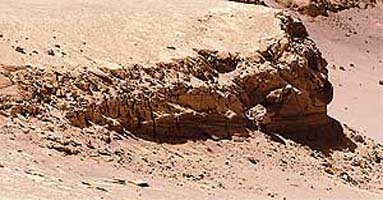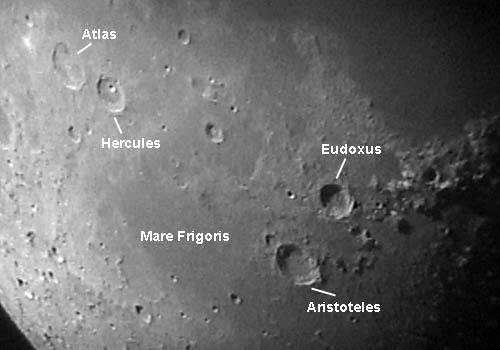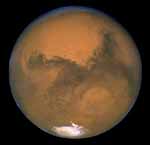|
|
|
|
|
|
|

This image of Mars obtained on Friday from NASA shows a view of the Victoria crater looking north from “Duck Bay” towards the dramatic promontory called “Cape Verde”. The dramatic cliff of layered rocks is about 50 m away from the rover and is about 6 m tall. This photo was taken by the panoramic camera on NASA’s Mars Exploration Rover Opportunity. |
|
| Moon probe set for crash
on lunar surface
03 Sep 2006 The first mission to the moon by the European Space Agency is due to end shortly in spectacular fashion. The Smart One spacecraft will be deliberately crashed onto the lunar surface, throwing up clouds of dust that will be analysed by scientists to see whether the moon was once part of the earth. The robot craft should come down on the nearside at mid-southern latitudes, in an area called the Lake of Excellence, at a speed of about 7,200km/h. The impact is set for 0543 GMT (0643 BST) on Sunday. Astronomers will follow the event from Earth. The BBC reports it is possible that telescopes will see fresh lunar "soil" kicked up in the crash. They may even detect a thermal flash as volatile materials on the probe melt some of its structure. Smart 1 was launched in September 2003. It became Europe's first space science mission to use an ion engine instead of chemical combustion to reach its destination. A fleet of spacecraft - both orbiters and landers - are now expected to visit the Moon in the next few years. 
|
|
| The first men on the moon had to use a pen to fix a broken switch | |
| The Truth Behind Our Manned Lunar Missions | |
|
Maya Calendar - End of the World - December 21, 2012 NASA'S Exploration Workshop Kicks Off Strategy Development Why are we going to the moon? What will we do when we get there? Approximately 200 participants from 13 countries grappled with these questions during NASA's Exploration Strategy Workshop, which concluded Friday. The four-day workshop was the first in a series of activities planned for 2006 focusing on defining a strategy for lunar exploration, including the role of the moon as a stepping stone to Mars and other destinations. Attendees included participants from federal agencies, aerospace companies, academia and entrepreneurial space commercialization companies. International participation brought attendees from Australia, Canada, China, the United Kingdom, France, Germany, India, Italy Japan, South Korea, Russia and Ukraine. After an initial day of background briefings, participants were assigned to one of seven multidisciplinary teams to identify the themes and objectives for lunar exploration and develop a list of issues and constraints requiring further consideration. "The collection of ideas, perspectives and justification for lunar exploration themes gathered from this workshop will be a blueprint anyone can use whenever a new opportunity for a lunar mission or activity arises," said NASA's Deputy Administrator Shana Dale. NASA will be working throughout
the summer to integrate the output from the workshop with several other
sources, including submissions received through a Request for Information
issued earlier this month.
|
|
| NASA postpones more shuttle
tank changes
Further redesign to wait until after planned flight in July April 28, 2006 CAPE CANAVERAL, Fla. - Despite concerns raised by some engineers, NASA said Friday that it plans to put off any further design changes to the shuttle's external fuel tank until after Discovery's flight in July. The space agency had been considering changing the design of the tank's so-called ice frost ramps to stop insulating foam from falling off. The ice frost ramps are wedge-shaped brackets that hold in place the tank's pressurization lines. NASA already has removed 37 pounds (16 1/2 kilograms) of foam from two other areas on the tank — a modification that space shuttle program manager Wayne Hale described as "the largest aerodynamic change we have made to the space shuttle launch system since it first flew."
|
|
| Hubble captures the shattering
of a comet
Friday, April 28, 2006 (CNN) -- NASA and the European Space agency have released new images from the Hubble Space Telescope showing the dramatic breakup of comet Schwassmann-Wachmann 3. The comet's nucleus has shattered into more than 33 pieces, and is likely to continue to disintegrate. Schwassmann-Wachmann 3 goes around the sun every 5.4 years, and is on course to make the closest approach of this orbit on June 7. Along the way, it will pass 7.27 million miles (11.7 million kilometers) from Earth on May 12. No piece is projected to hit Earth. European astronomers captured
a series of still images of the fragmentation using an instrument aboard
the Hubble called the Advanced Camera for Surveys. They assembled those
images into a time-lapse movie that shows the breakup in the kind of detail
not possible with ground-based telescopes. Astronomers say the smallest
pieces of comet visible in the Hubble images are probably the size of a
house
Comets are "dirty snowballs," chunks of ice and rock left over from the formation of the solar system 4.5 billion years ago, scientists say. They circle the sun in irregular orbits, moving as far away as the outer fringes of the solar system before swinging back in. When comets get close to the sun, they heat up. Trapped gases inside the nucleus expand and sometimes explode out. Particularly energetic "jets" of gas can blow a comet apart, or make it vulnerable to the forces of gravity as it passes by planets or the Sun. Schwassmann-Wachmann 3 is not the first comet astronomers have watched shatter. Shoemaker-Levy 9 was ripped to pieces by the gravity of the planet Jupiter in July 1992, made a final pass around the sun, and then slammed into Jupiter's atmosphere nearly two years later.
|
|
| Major dust storm on Mars
Storm area visible with backyard telescopes Friday, October 28, 2005 A major dust storm has just broken out on Mars and the event will be visible this weekend with good-sized backyard telescopes. The timing is incredible. Amateur skywatchers around the world are planning to gaze at Mars Saturday night because it will be closer to Earth than anytime until the year 2018. The dust storm was no more than a small bright dot Thursday yet it was large and obvious Friday, as seen in images taken by Clay Sherrod at the Arkansas Sky Observatories. NASA took note and is monitoring signals from its Mars rovers, one of which has detected signs of the storm, SPACE.com has learned. The storm "will be quite obvious and plainly visible in even small telescopes from the Western Hemisphere for about the next week," Sherrod said in an email to colleagues that was forwarded to SPACE.com. The storm has seven appendages that stretch in all directions, Sherrod said. The overall cloud is about 700 to 800 miles across, according to estimates by longtime Mars-watcher Joel Warren, Sherrod said. Warren, of Amarillo, TX, told SPACE.com that he took the first image of the storm rotating into view early Friday using his 8-inch telescope. He notified Sherrod and others of its existence. The dusty cloud is spreading at a speed of about 35 mph and may become larger by the weekend. Dusty planet
In 2003, Mars made the closest pass to Earth that had occurred for 60,000 years. This weekend, it won't be quite that close, but still better than the other close approaches it makes every 26 months. Earth is closer to the Sun, so it effectively passes Mars every 26 months as both worlds orbit the central star. Mars will be 43,137,071 miles (69,422,386 kilometers) from Earth at around 11:25 p.m. ET Saturday. In truth, the view will be basically the same as the night before and the night after. But the event is being marked by star parties in many communities. Sherrod said the dust storm is not currently visible during nighttime hours from Europe or Australia. Mars is a fuzzy point of light in the late evening sky now, in the East. In the predawn, it looms in the western sky. Small telescopes will reveal Mars as a disk, rather than a point of light. Good-sized backyard telescopes, generally about 3 inches or larger, show details of the planet's surface. The view from Mars
"This may be the second biggest dust storm that Opportunity has seen," Mark Lemmon, a rover science team member from Texas A&M University, told SPACE.com, adding that he has seen the images taken by Sherrod. "I'd seen those this morning and I waited very impatiently for the rover's downlink to come in." Lemmon said that data returned to Earth Friday by Opportunity showed elevated dust levels at Meridiani Planum, which were measured at an optical depth of about 1.4. The largest dust storm experienced by the rover occurred in June and rated an optical depth of about 2, he added. For comparison, a smoggy day in Los Angeles would rate an optical depth of about 1.0, and moderate days on Mars are about 0.5, NASA officials said. Martian dust storms blot out sunlight from rover panels, but otherwise are relatively harmless to the robotic explorers, Lemmon said. While dust storm activity in Opportunity's region of Mars is winding down, team members with NASA's Mars Global Surveyor orbiters noticed a rise in activity about two weeks ago, Lemmon said, adding that researchers are not sure how large the current storm could grow. "We started seeing more and more dusting on the solar panels," he added. "And we have indirect evidence that these storms are windy. We've seen material blown out of the rover tracks over the last two weeks." Tickled by the fingers
"Because we got the warning that something was happening...we were able to get in some atmospheric observations in," Lemmon said. "So if this does give us a direct hit over the rover, we're ready." Lemmon said he and other researchers are eager to learn the properties of the dust within the storm and compare it to the material Opportunity sees daily. Meanwhile, Opportunity's robotic twin Spirit has found some signs of additional atmospheric dust at its Gusev Crater landing site on the other side of Mars. Lemmon said Spirit detected an optical depth of about 0.6, still well within the moderate range, but would likely not experience as significant an increase in dust levels as Opportunity. |

|
| What is a Solar system |
| LUNAR COLLECTION | SOLAR COLLECTION | MARS | Home |
| India, New Delhi From Space |
|
|
|
|
|
|
|
|
|
|

Welcome to Swami Rajesh Chopra's |

|
( The Trade Marks Act, 1999, No. 01403083. User Since : 01/04/1997 ) All rights reserved. No part of this publication and other sites of under liveindia.com may be transmitted or reproduced in any form or by any means without prior permission from the publisher Live India Internet Services or Rajesh Chopra, L.C.Premium Cables, 1826, Amar Nath 2nd Building, Bhagirath Palace Delhi - 110006, India. Liveindia.com or Mr.Rajesh Chopra is not responsible for any wrong information under this site, For confirmation of any information it is recomended that you can reconfirm from yours end. |
 |